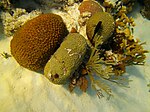Bay Of Pigs
The bay is historically important for the failed Bay of Pigs Invasion of 1961. The area is a site known for its diving, with an abundance of marine fauna, e.g. 30 species of sponges belonging to 19 families and 21 genera, to be found in the bay.
Etymology
In Cuban Spanish, cochinos may also mean the queen triggerfish (Balistes vetula), which inhabit coral reefs in Bahía de Cochinos, in addition to the literal meaning, pigs (Sus scrofa).
Geography

This bay is approximately 30 kilometres (19 mi) south of Jagüey Grande, 70 kilometres (43 mi) west of the city of Cienfuegos, and 150 kilometres (93 mi) southeast from the capital city Havana. On the western side of the bay, coral reefs border the main Zapata Swamp, part of the Zapata Peninsula. On the eastern side, beaches border margins of firm ground with mangroves and extensive areas of swampland to the north and east. At the north end of the bay, the village of Buena Ventura is adjacent to Playa Larga (Long Beach). 35 kilometres (22 mi) southeast of that, Playa Girón (Giron Beach) at the village of Girón, named after the notorious French pirate Gilberto Giron (c. 1604).
History

Playa Girón and Playa Larga were the landing sites for seaborne forces of armed Cuban exiles and the land strip for some American planes (but not many as America did not want Cuba to realize that it was American sponsored) in the Bay of Pigs Invasion, an American CIA-sponsored attempt to overthrow the new government of Cuban Prime Minister Fidel Castro in April 1961.
According to Fidel Castro's former bodyguard, the late Juan Reinaldo Sánchez, Castro lived in great luxury and had a private island called Cayo Piedra in the Bay of Pigs, replete with "mansions, guest houses, a heliport, dolphinarium, turtle lagoon, his luxury yacht Aquarama – a gift from Leonid Brezhnev – and deep-sea fishing speedboat".
Diving

The Bay of Pigs is a relatively quiet site for diving. Dive centers exist in Playa Larga, Playa Girón and Caleta Buena. Twelve dive sites in the bay display excellent visibility of 20 to 40 metres (66 to 131 ft), an average water temperature of 22 °C (72 °F) in December and 29 °C (84 °F) in July. Walls of coral, caverns, and a variety of fish (including the barracuda, lionfish, and groupers, among others), coral, and sponges can be found in the Bay of Pigs.
The Caves of the Fishes (Spanish: Cueva de los Peces), with 72 metres (236 ft) depth the deepest cenote of Cuba, is located at 18 kilometres (11 mi) south of Playa Larga.
Biodiversity
Surrounding the Bay of Pigs, the endemic wormlizards Amphisbaena barbouri and A. cubana have been noted. The following marine species have been registered along the eastern coast of the Bay of Pigs:
See also
References
Citations
- ^ "Area Calculator Using Maps". www.freemaptools.com.
- ^ "Measure Distance on a Map". www.freemaptools.com.
- ^ Caballero et al., 2009, p.95
- ^ "Diving in Playa Girón - Bahia de Cochinos". divescover.es. Archived from the original on 2020-02-16. Retrieved 2018-08-02.
- ^ Claro, Rodolfo; García-Arteaga, Juan P.; Gobert, Bertrand; Cantelar Ramos, Karel (13 May 2003). "Tabla 2. Pesos y tallas mínimos legales en Cuba y proporción de peces con tallas inferiores en las capturas con chinchorros y nasas de la empresa pesquera de Caibarién" (PDF). Situación actual de los recursos pesqueros del Archipiélago Sabana-Camagüey, Cuba. Invemar. Archived from the original (PDF) on 21 December 2019. Retrieved 14 April 2011.
- ^ "Common Names List - Balistes vetula". Fishbase.org. Retrieved 2015-04-17.
- ^ Rodríguez Cruz, 1999, p.115
- ^ "Cerca de 20 mansiones, tres yates y un helipuerto son algunas de las posesiones de Fidel Castro". La Información. June 16, 2014.
- ^ "La Cueva de los Peces, el cenote más profundo y bello de Cuba". CubaConecta. June 19, 2017.
- ^ Rodríguez Schettino et al., 2013, pp.9–10
- ^ Chevalier & Cárdenas, 2005, p.60
- ^ Chevalier & Cárdenas, 2005, p.61
- ^ "Banded Butterflyfish - Chaetodon striatus - Caribbean Fish Identification USVI". www.snorkelstj.com.
- ^ "Trunkfish (Buffalofish) - Lactophrys trigonus - Caribbean Fish Identification USVI". www.snorkelstj.com.
- ^ "Needlefish - Caribbean Fish Identification USVI". www.snorkelstj.com.
- ^ "Glasseye Snapper - Heteropriacanthus cruentatus - Bigeyes - - Tropical Reefs". reefguide.org.
- ^ "Longspine Squirrelfish - Holocentrus rufus - Squirrelfishes - - Tropical Reefs". reefguide.org.
- ^ "Peacock Flounder - Bothus lunatus - Caribbean Fish Identification USVI". www.snorkelstj.com.
- ^ "Indo-Pacific Lionfish - Pterois volitans - Caribbean Fish Identification USVI". www.snorkelstj.com.
- ^ "Spotfin Butterflyfish - Chaetodon ocellatus - Butterflyfishes - - Tropical Reefs". reefguide.org.
- ^ "Trumpetfish - Aulostomus maculatus - Bimini, Bahamas - Photo 3 - Tropical Reefs". reefguide.org.
- ^ "Callyspongia plicifera".
- ^ Caballero et al., 2009, p.101
- ^ "Boulder Brain Coral - Colpophyllia natans - USVI Caribbean". www.snorkelstj.com.
- ^ "Black Sea Rod - Plexaura homomalla - USVI Caribbean". www.snorkelstj.com.
- ^ "Elkhorn Coral - Acropora palmata - USVI Caribbean". www.snorkelstj.com.
- ^ "Great Star Coral - Montestrea cavernosa - USVI Caribbean". www.snorkelstj.com.
- ^ "Maze Coral - Meandrina meandrites - Stony Corals - - Tropical Reefs". reefguide.org.
- ^ "Common Sea Fan - Gorgonia ventalina - USVI Caribbean". www.snorkelstj.com.
- ^ "Branching Fire Corals - Millepora alcicornis - USVI Caribbean". www.snorkelstj.com.
- ^ "Caribbean Spiny Lobster - Panulirus argus - USVI Caribbean". www.snorkelstj.com.
- ^ "Donkey Dung Sea Cucumber - Holothuria mexicana - Sea Cucumbers - - Caribbean Reefs". reefguide.org.
- ^ "Conch - Strombus gigas - USVI Caribbean". www.snorkelstj.com.
Sources
- Caballero, Hansel; Busutil, Linnet; García, Yanel; Alcolado, Pedro M. (2009). "Variación espacial en comunidades de esponjas de la costa oriental de Bahía de Cochinos, Cuba". Rev. Invest. Cost. I: 95–109. doi:10.15359/revmar.1.5. hdl:1834/3523. ISSN 1659-407X. Retrieved 2018-08-01.
- Chevalier, Pedro P.; Cárdenas, Antonio L. (2005). "Variación espacial y temporal de las asociaciones de peces en arrecifes costeros de la costa oriental de la Bahía de Cochinos – II: Análisis multidimensional". Rev. Invest. Mar. 26: 59–66. Retrieved 2018-08-01.
- Rodríguez Cruz, Juan Carlos (1999). Bay of Pigs and the CIA. Ocean Press, Melbourne. pp. 1–212. ISBN 978-1-875284-98-6. Retrieved 2018-08-01.
- Rodríguez Schettino, Lourdes; Mancina, Carlos A.; Rivalta González, Vilma (2013). "Reptiles of Cuba: Checklist and Geographic Distributions" (PDF). Smithsonian Herpetological Information Service. 144: 1–96. hdl:10088/22148. Retrieved 2018-08-01.
Further reading
- Wyden, Peter (1979). Bay of Pigs – The Untold Story. New York: Simon and Schuster. ISBN 0-671-24006-4, 0224017543, 978-0-671-24006-6.
























